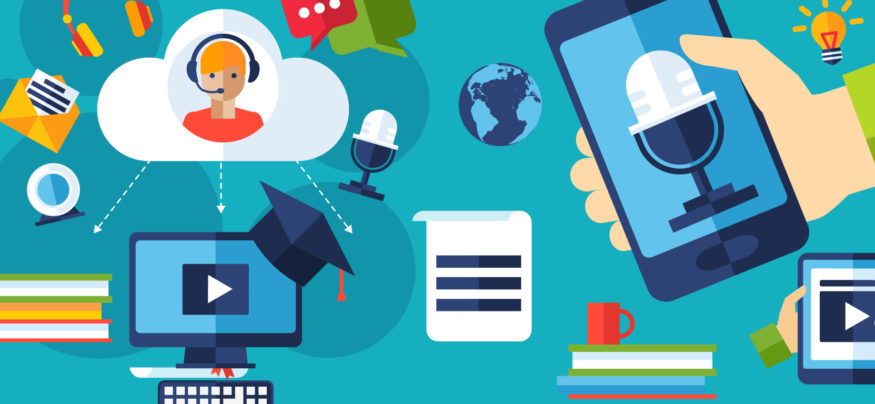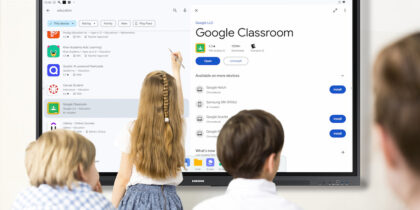A growing number of teachers are using educational podcasts in their classrooms to enhance student engagement and outcomes. Podcasts allow students to download and listen to content from nearly any device while they’re on the go, review content as many times as needed to understand the material, practice their listening and critical thinking skills, and even develop their reading skills.
Yes, reading skills. It might sound strange, but California teacher Michael Godsey reports that his students are reading with more attention — and their comprehension scores have improved — since he began displaying transcripts while his students listen to podcasts in class, a practice he calls “a game-changer.”
The Rise of Podcast-Based Lessons
According to The Atlantic, TeachersPayTeachers, an online marketplace in which teachers pay teachers for lesson plans they’ve created, reports that annual downloads of podcast-based lessons increased by 21 percent in 2014, and by 650 percent in 2015.
Much of that activity is owed to Godsey himself, who has published full-season lesson plan bundles on TeachersPayTeachers containing hundreds of pages of exercises, links, quizzes, prompts and other material for using the podcast “Serial,” launched in 2014, as a core instructional tool.
A Number of Uses
Educational podcasts serve many useful purposes. The site Educational Technology and Mobile Learning details the benefits of educational podcasts:
- Podcasts are a great option for delivering lessons to students who need remedial or additional support.
- Students can create their own podcasts to collaborate and share their learning with each other and with students from other schools. Creating podcasts helps students develop crucial skills like researching, writing, speaking effectively, solving problems and improving vocabulary.
- Teachers can record podcasts of their lessons to give students an opportunity to download and review the material at a time that’s convenient for them.
- Podcasts can benefit auditory learners, and they can help all students practice their listening skills — which the Common Core State Standards identify as a core skill for ELA instruction.
Podcasts can also lead to more engaged and active learning, and can benefit students of all ages. Scholastic highlighted nine high-quality educational podcasts for students in grades K–8, and The American Board has compiled a list of the top 10 podcasts for students in grades 6–12. There are also a number of STEM-related podcasts that are relevant for students.
Replacing Shakespeare with “Serial”?
While they’re technically not educational podcasts, the first two seasons of “Serial” have become the most significant instructional resources that Godsey uses in his 10th- and 11th-grade English classes at Morro Bay High School.
“Serial” is a podcast from the creators of “This American Life,” narrated by Sarah Koenig. Season 1 follows Koenig’s investigation of the 1999 murder of Hae Min Lee, a student at a Baltimore high school; Season 2 focuses on the case of Sgt. Bowe Bergdahl, an American soldier who was held for five years by the Taliban, then arrested for desertion.
“Loving literature doesn’t have to be confined to a classroom — it’s a real thing,” Godsey says. “When Sarah Koenig says dramatically, ‘I knew one of these guys was lying. I just wanted to know which one,’ this screams for deep literary analysis while it’s also superficially enjoyable.”
Godsey has his students analyze Koenig’s storytelling, determine whether she’s a biased or reliable narrator and even perform their own investigation. Students “spent an hour poring over maps of Baltimore, the cell phone records and Jay’s narrative to see if they could make any certifiable conclusions,” he says. “They loved how contemporary it was, they loved the high school setting, they loved the reality of it and they felt like they could solve the crime themselves.”
All told, he devised at least 30 exercises and activities around “Serial” that were based on the Common Core. The lessons were “much easier — and more fun — to do with this story than most novels,” he says.
Season 2 added full-length transcripts, and Godsey has his students read along as they listen to the podcast. “Since I’ve been projecting the transcripts, I’ve seen a tangible improvement in scores on reading comprehension assessments,” he says. “The most exciting thing, though, is just watching them read with more sustained attention than they normally do.”
Godsey published a blog post called “I’m replacing Shakespeare with ‘Serial’,” and he expected to get a lot of negative feedback. “Instead, I’ve been getting an email every week from a happy teacher,” he says, “who tells me about how her class of low-performing readers are suddenly engaged and excited to look deeply into a story with an adult level of vocabulary and complexity.”
Podcasts aren’t the only trend that’s changing the ways students engage with material. Learn more about the latest education innovations here.








